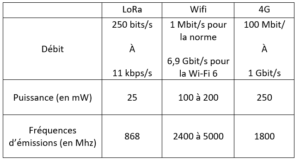The LoRa (Long Range) network is a low-speed, long-range radio communication technology used for IoT (Internet of Things) solutions. This network enables connected objects to transmit data.

Published on 15 April 2024
Discover LoRaWAN, the long-range radio protocol
In this article:
What is the LoRa network protocol?
Thanks to its technology, the LoRa network consumes less energy than other wireless networks (Wifi, 4G, Sigfox, etc.). What’s more, this advantage extends the service life of the sensors connected to the network.
This technology uses 868 MHz free radio frequencies. In addition to its low energy consumption compared with the networks mentioned in the previous paragraph, LoRa’s penetration capacity is very good. Indeed, the latter can provide deep indoor coverage and can easily cover multi-storey buildings and businesses.
LoRa is the name given to the radio wave modulation technology on which LoRaWAN networks are based.
LoRa is one of the solutions that enable connected objects to exchange data and communicate with each other. To do this, they have to comply with a certain protocol: LoRaWAN. The latter is an extension of the LoRa protocol, ensuring secure connection of the product to a server. This connection is then used to transmit data to the end user. This network is therefore used for many connected objects and equipment designed to reduce energy consumption, such as smoke detectors, temperature & humidity detectors, carbon dioxide (CO2) and carbon monoxide (CO) detector.
LoRaWAN network flexibility for the IoT
An easily accessible network
The LoRaWAN network is an “open” network, meaning that any company wishing to use it can deploy its own network to make objects communicate. To do this, the company needs an antenna connected to the Internet (Wifi, cable, 4G, etc.). It also needs to acquire a gateway communicating on the 868MHz band. Depending on the country, the band used may be different. In the USA, for example, this is the 915MHz band.
Variable flow
One of the main advantages of LoRa technology is its adaptive throughput. In fact, the network and the objects communicating with this technology can vary the data transmission rate. This process extends the life of the sensors: up to 10 years for some products!
Two-way communication
The LoRaWAN network has the ability to “hear” the data transmitted by sensors, and in turn transmit it. This feature is useful for configuring sensors as actuators (closing shutters, switching off heating, activating a fan, etc.). Depending on the model, the sensors can be configured remotely. The LoRa network is one of the few IoT networks to offer this type of process.
LoRa has many other features. This radio protocol is the most widely used today.
Are LoRa waves harmful to health?
This low-speed, long-range radio communication technology is not considered hazardous to health. Its radio waves are used specifically for IoT devices.
These waves are not dangerous, as long as you comply with established safety standards and exposure levels.
By way of comparison, the Wifi radio protocol and 4G are very high in terms of transmission frequencies, power and throughput.
LoRa equipment is recommended because of its low power demissions and lower data rates. The bit scale is as follows: bits < kilobits < megabits < gigabits.
LoRa radio waves pose no health risk. Low-power radio emissions, such as those used in LoRaWAN networks, are regulated by strict safety standards.
Used in IoT solutions, this technology is in no way dangerous to human health. That’s why the LoRa network is being used in so many fields.
On the LoRaWAN network, the devices that communicate can be :
- Temperature and humidity;
- Carbon dioxide (CO2);
- Carbon monoxide (CO ) ;
- Fine particulate matter (PM ) ;
- Formaldehyde (HCHO);
- Volatile organic compounds (VOCs ) ;
- Brightness and presence.
How do I get a LoRa network?
First of all, to operate, a LoRa network connects to an antenna, which acts as a gateway for data. These are then directed to a dedicated application. Some companies are looking for a private LoRa network. Thanks to the gateways, they create a kind of network bubble around the buildings in which their sensors are installed.
Public networks
A public network is managed by an operator. It is available to anyone with a subscription (Orange, for example). Users can connect to it and use it to operate connected objects, monitor their environment using sensors, and so on. The operator is solely responsible for the maintenance, operation and safety of the network.
However, these public networks can have uneven coverage depending on the geographical area. Where security is an issue, private networks may be the best choice.
Private networks
The LoRaWAN network is usually deployed and managed by a company, local authority or organization to support its own needs. This network is used to meet the specific needs of an organization. On this network, it is possible to :
- Manage a fleet of sensors designed to measure the energy efficiency of intelligent buildings;
- Observe confined-space environments, with equipment to measure temperature and humidity, carbon dioxide (CO2), carbon monoxide (CO), fine particles (PM), etc. ;
- Connect smoke detectors.
The owner of this network is solely responsible for its operation, safety and maintenance.
Owning a private LoRaWAN network gives you total control and the ability to personally manage its maintenance and security. The data exchanged using this radio protocol is not accessible to the public, which reinforces the security of the information transmitted. This feature also ensures the confidentiality of exchanged data.
Does Nexelec offer private networks?
Nexelec offers a turnkey solution with connected sensors, a private LoRaWAN network, and an application to visualize the data. The gateway ‘s coverage zone varies between 50 and 100 meters, depending on the type of building. If the walkway is installed in the middle of a building, then it can easily cover the floor above and the floor below without any problem. In addition to these levels, installed sensors may have difficulty communicating due to a weaker signal. Depending on your needs, Nexelec supplies indoor or outdoor gateways, preconfigured for 4G or Ethernet.
LoRa is a low-speed, long-range radio communication technology. Used for the Internet of Things (IoT), it enables connected objects to transmit data without excessive power consumption. It also has good building penetration capacity. What’s more, this technology is harmless to human health. With all the advantages offered by private LoRaWAN networks, it’s only natural that more and more companies are opting for this type of technology for connected objects.
